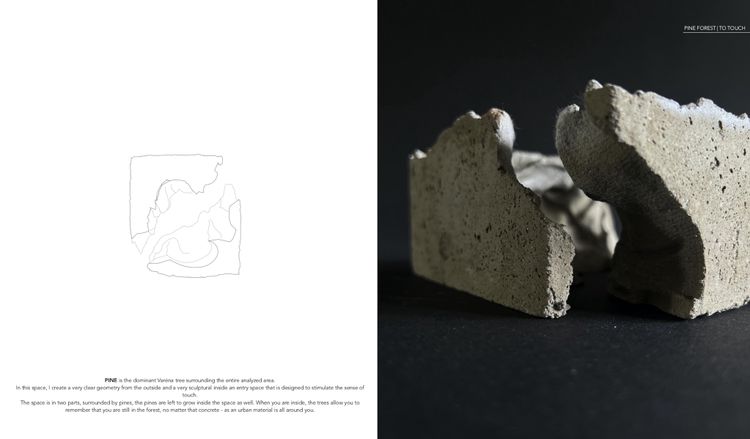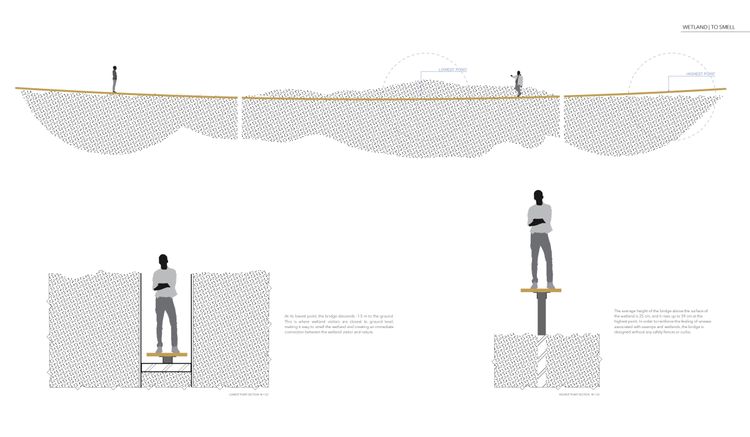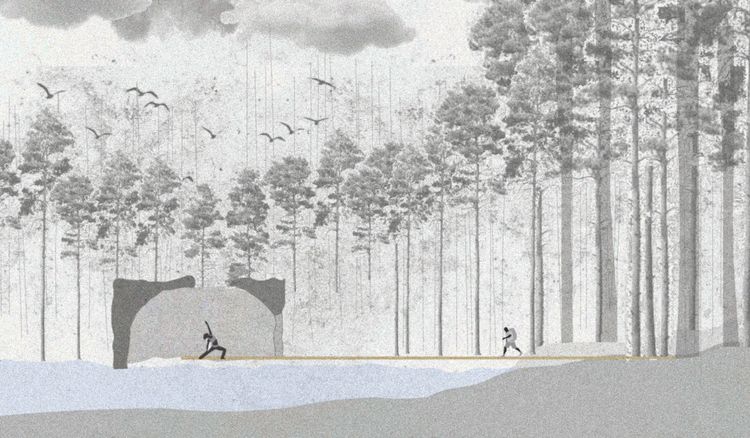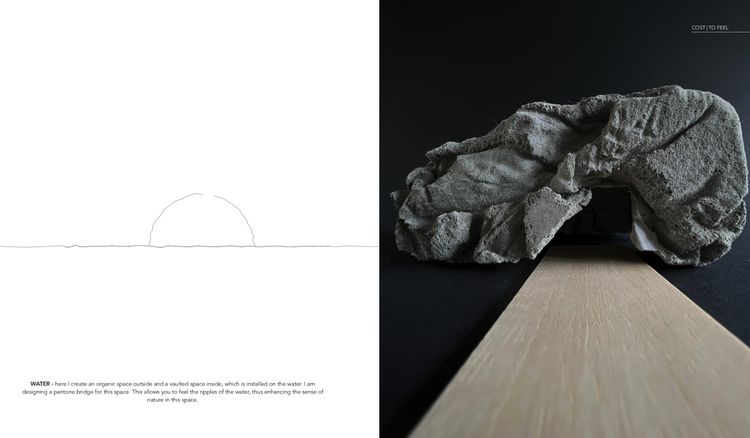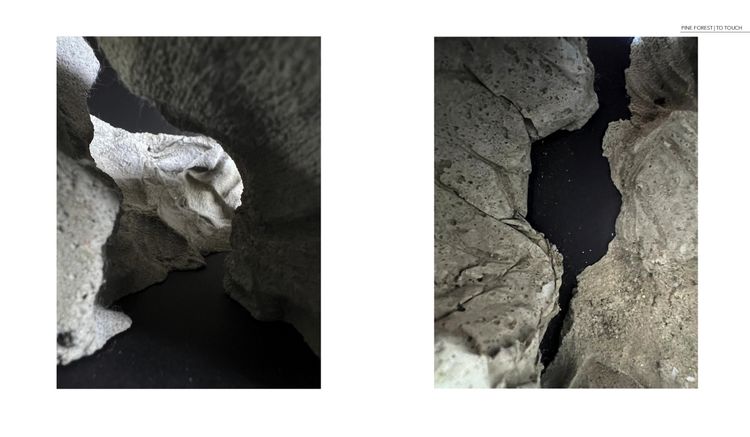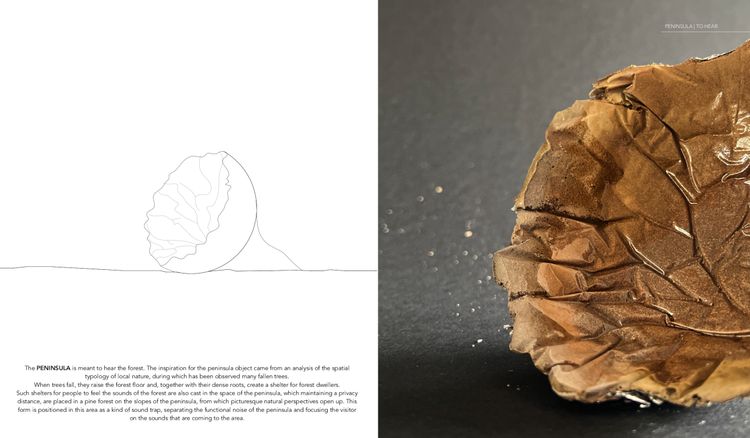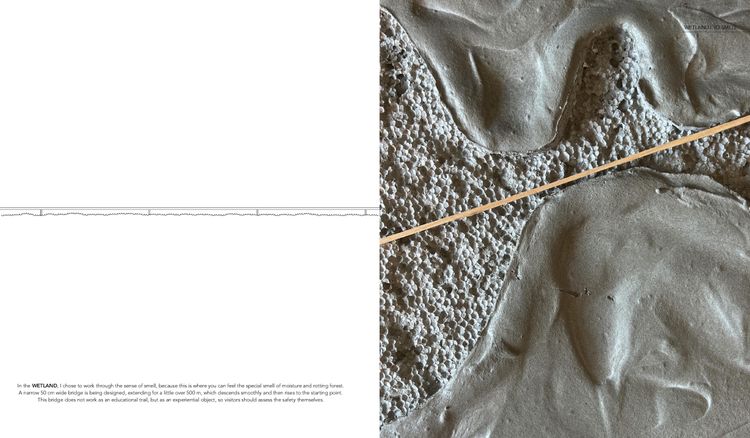Gamta architektūroje. Erdvinių patirčių Varėnos tvenkinių teritorijoje projektas
Autorius
Margarita Stanulevičiūtė, doc. Rokas Kilčiauskas
NUOTRAUKŲ AUTORIUS
Margarita Stanulevičiūtė
METAI
2022
-LT- (VDA | Interjero dizaino katedra | Bakalauro baigiamasis darbas) „GAMTA ARCHITEKTŪROJE. Erdvinių patirčių Varėnos tvenkinių teritorijoje projektas“ Dabartinė kraštovaizdžio architektūra linksta link specifinio požiūrio į žmogaus ir gamtos santykį per patirtį. Labiau nei bet kada šiandien kraštovaizdis suvokiamas, kaip neįkainojamas paveldas, kurį architektūra gali ir turi sustiprinti, saugodama jį ateities kartoms. Šio projekto tikslas buvo sukurti erdvinį patyriminį pasakojimą gamtinėje aplinkoje, kuris veiktų žmogaus pojūčius ir leistų visapusiškai panirti į dialogą su kraštovaizdžiu bei jo elementais. Erdvės kuriamos atsižvelgiant į vietos duotybes: pakrantę, vandenį, šlapynę, pusiasalį ir pušyną, tačiau objektai sąmoningai nėra išbaigti iki detalių, palikta vieta interpretacijai. Tai labiau eksperimentai apie erdves ir jų kuriamą atmosferą. Tai abstrakčios formos, paviršiai ir erdvės, kurios per medžiagiškumą ar kompoziciją sukuria specifinę nuotaiką ir atmosferą. Tai lyg sustabdyta akimirka, ir kiekvienas žiūrėtojas šį projektą išbaigia pats. Svarbiais aspektais tapo medžiaga ir kuriama vietos ir laikinio momento atmosfera. Lietuvos gamta yra pakankamai subtili, todėl tam, kad objektai susilietų su kraštovaizdžiu ir vartotojui nesukurtų konflikto su aplinka, daug dėmesio buvo skiriama medžiagai, kuri kartu su projektuojamais objektais kuria subtilią darną ir ypatingą, žmogaus jusles stimiliuojančią atmosferą. Medžiaga neatsitiktinai parinkta viena natūraliausių iš dirbtinių, atvira ir pakankamai plastiška prisitaikyti, didelis dėmesys buvo skiriamas ir tam, kaip ši medžiaga panaudota ir kokia technologija pritaikyta jai sukurti. Kūrybiniam darbui įgyvendinti buvo taikomas maketavimo metodas, kuris atliepia plėtojamą atmosferinę - percepcinę tematiką. Maketams kurti neatsitiktinai pasirenkamos realios medžiagos – betonas ir medis. Toks sprendimas leidžia perteikti realiai kuriamą emociją, o žiūrėtojams leidžia pajausti prognozuojamą atmosferą ir nuotaiką. Betonas be kita ko kuria kontrasto nuotaiką gamtinėje aplinkoje ir koreliuoja su projekto koncepto idėja MIŠKAS KAIP MIESTAS, ir šiame miške kuriama kaip mieste, tai lyg miesto elementų pritraukimas į gamtinę teritoriją. Objektų medžiagiškumo sprendimas priimtas ne tik atsižvelgiant į išvardintas sąlygas, tačiau ir siekiant šių objektų ilgaamžiškumo ir tvarumo, taip pat pasirinktos medžiagos mūsų klimato sąlygomis su laiku kis kaip, kis ir juos supanti gamta. -EN- (VAA | Interior Design department | Bachelor thesis) “NATURE IN ARCHITECTURE. Spatial experience project in Varėna ponds territory“ Current landscape architecture tends towards a specific approach to the relationship between human and nature through experience. Today, more than ever, the landscape is perceived as a priceless heritage that architecture can and must enhance, protecting it for future generations. The aim of this project was to create a spatial experiential narrative in a natural environment that would engage the human senses and allow full immersion in a dialogue with the landscape and its elements. The spaces are designed with the benefits of location in mind: coast, water, wetland, peninsula and pine forest, but the objects are deliberately not finished down to the details, leaving place for interpretation. It‘s like experiments about spaces and the atmosphere they create. It‘s abstract forms, surfaces and spaces that create a specific mood and atmosphere through materiality or composition. It's like a suspended moment, and each viewer completes this project himself. The material became important aspects and created the atmosphere of the place and the moment in time. The nature of Lithuania is quite delicate, therefore, in order for the objects to merge with the landscape and not to create a conflict with the environment for the user, a lot of attention was assigned to the material, which, together with the designed objects, creates a delicate harmony and a special atmosphere that stimulates the human senses. The material was not randomly chosen, it‘s one of the most natural of the artificial ones, open and plastic enough to adapt, great attention was also assigned to how this material was used and what technology was used to create it. A modeling method was used to implement the creative work, which responds to the atmospheric - perceptual theme being developed. Real materials - concrete and wood - are not chosen randomly to create models. This solution allows to convey the emotion that is actually being created, and allows viewers to feel the projected atmosphere and mood. Among other things, concrete creates a mood of contrast in the natural environment and correlates with the idea of the project concept FOREST AS A CITY, and in this forest it is created as a city, it is like attracting urban elements to the natural area. The decision on the materiality of the objects was made not only taking into account the listed conditions, but also in order to achieve the longevity and sustainability of these objects, in our climate conditions, the chosen materials will change with time, as the nature will change around them too.

